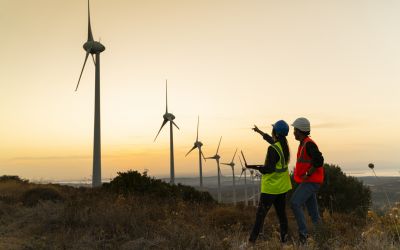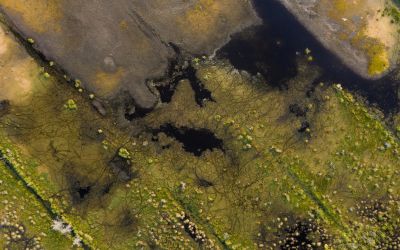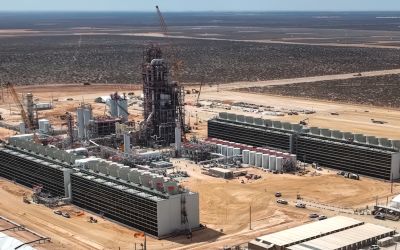Dr. Simon Morgan on Reaching Biodiversity Goals Through the NARIA Framework
Following the inaugural Nature Finance Forum Europe, Climate Action spoke with Dr. Simon Morgan, International Lead at CreditNature.
.png)
Dr Simon Morgan is a conservation ecologist with over two decades of expertise in biodiversity monitoring, conservation technologies, and innovative financing mechanisms for nature. As Founder and former CEO of ValueNature, he led efforts to align financial investments with measurable nature restoration outcomes. Following the merger of ValueNature with CreditNature, Simon now leads the company’s international project development. He plays a key role in scaling high-integrity biodiversity credit markets globally and is currently working with partners to establish an African Buyers Club. Simon holds a PhD in Conservation Ecology and is committed to driving innovative, scalable solutions to nature recovery while ensuring biodiversity markets deliver both environmental and social returns.
1. CreditNature is championing the NARIA Framework as a tool to operationalise biodiversity goals. What makes NARIA different from other nature-based investment or policy frameworks currently in use?
What sets NARIA apart is its systems-level approach to ecosystem recovery. Unlike many frameworks that focus on species or habitat-level metrics, NARIA treats ecosystems as critical infrastructure—valued and managed as dynamic, self-sustaining assets. It is the only framework to feature an independently certified Ecosystem Condition Index (ECI), allowing standardised, science-based measurement of ecological integrity across regions. This enables the generation of comparable nature credit outcomes between projects. Delivered via a digital platform, NARIA also streamlines onboarding, monitoring, and reporting, making it scalable and transparent for policy and market use. Its design allows it to serve dual functions: operationalising national biodiversity goals and catalysing high-integrity nature markets, including for climate co-benefits. Whilst it is predominantly and ecosystem condition methodology, the level of data collected within the system also provides key insights about habitats and species.
2. Can you explain how the NARIA Framework aligns with global reporting mechanisms like the CBD Global Biodiversity Framework and TNFD, and why this alignment is so important?
NARIA aligns with the CBD Global Biodiversity Framework and TNFD by translating ecosystem condition and land management impacts into standardised, auditable metrics. For the GBF, it directly supports Goal A by enabling measurable progress towards Targets 1, 2, and 3—on spatial planning, ecosystem restoration, and conservation. For TNFD, NARIA provides the metrics, data architecture, and verification pathways needed to assess and disclose nature-related dependencies, impacts, and transition risks. This alignment ensures NARIA’s outputs are not only science-based but also decision-grade, helping investors and corporates make informed, credible, comparable disclosures and demonstrate progress toward nature-positive outcomes.
3. The framework puts strong emphasis on ecosystem integrity. How does CreditNature ensure the scientific robustness of ecosystem condition assessments and credit issuance?
CreditNature ensures scientific robustness through the design, certification, and verification of its Ecosystem Condition Index (ECI). The ECI is grounded in the UN System of Environmental-Economic Accounting – Ecosystem Accounting (UN SEEA-EA), aligning with internationally accepted science and standards. It has been independently certified by Accounting for Nature®, which subjects methods to a rigorous scientific review by its Science Accreditation Committee. Beyond this, each application of the ECI undergoes a structured validation and verification process by Accounting for Nature and additionally by our digital platform and independent auditors — ensuring data quality, metric reliability, and transparency from baseline to credit issuance. This gives both policy actors and investors confidence that claimed improvements in ecosystem integrity are measurable, verifiable, and globally credible.
4. What role do national governments play in scaling high-integrity biodiversity credit markets and how is CreditNature working with policymakers to catalyse action?
National governments are essential to scaling high-integrity nature markets—they create the enabling policy environments, can integrate credits into national targets, and ensure alignment with global frameworks. CreditNature supports this by working closely with governments to embed the NARIA Framework into national biodiversity strategies. We're actively collaborating with the Scottish Government, NatureScot and SEPA to design a voluntary nature credit market—demonstrating how policy, science, and market infrastructure can be integrated. Additionally, we co-developed the Ecosystem Restoration Code and NARIA is recognised within Scotland’s emerging Natural Capital Markets Framework. Beyond Scotland, we’re piloting in other countries and are engaging with these and other governments to develop frameworks that channel private finance into nationally aligned restoration outcomes and biodiversity strategies.
5. The digital platform appears as a key component of NARIA. Can you talk us through its capabilities and how it supports transparency, reporting, and investor confidence?
The CreditNature digital platform serves as the operational backbone of the NARIA Framework, embedding transparency, accountability, and traceability into every step of the nature credit life cycle. Aligned with international best practices (for example meeting the IAPB/WEF/BCA High Level Principles), the platform digitises the full implementation of the Ecosystem Condition Code—turning complex scientific and policy requirements into validated workflows. It functions as a secure, auditable repository for ecosystem data, ensuring verifiable condition assessments, metric calculations, and project tracking.
Stakeholders—including suppliers, developers, verifiers, and auditors—are assigned defined roles and responsibilities, with all actions recorded and accessible according to robust data governance protocols. Public disclosures on project type, condition scores, and credit issuance status build democratic transparency and help buyers and policymakers evaluate integrity. By enabling consistent data flows, structured verification, and market-grade reporting, the platform significantly boosts confidence for investors and governments alike.
Find out more about the NARIA Framework here






